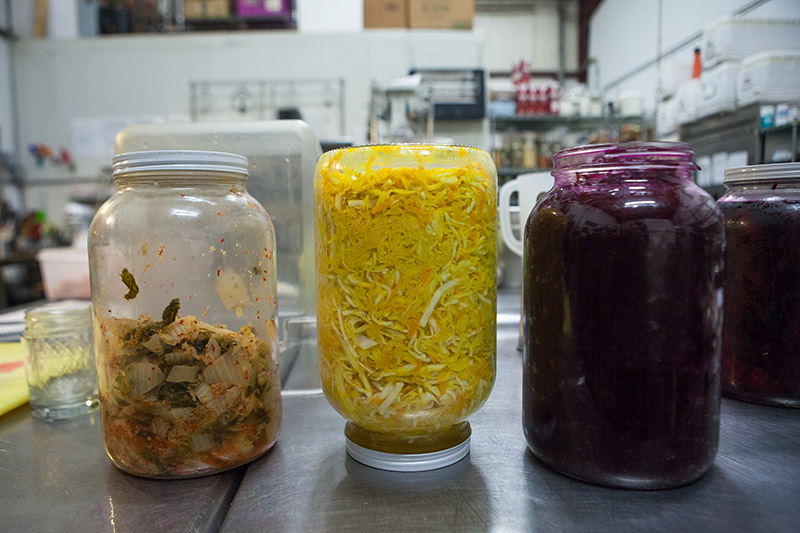Kimchi, turmeric fermented cabbage, and fermented spiced beets.
Most of us consume cultured and fermented foods — yogurt, sourdough bread, kimchi, and more — but the majority of home cooks here have never tried making them from scratch, even though they have all the tools they need at hand. Natural fermentation, or lacto-fermentation, is a common process that’s been a part of traditional food cultures all over the world since the beginnings of culinary history, requiring nothing more than clean jars, salt, and water, plus whatever is going to be pickled.
It has a rich folklore, with some traditions declaring that sauerkraut must be made during the waxing phase of the moon, while others will start it only when the moon is waning (experiments suggest that either way is fine). In the United States, natural fermentation fell out of fashion in the 20th century, until all that was left were a few lonely cans on supermarket shelves, but now it’s seeing a revival.
Jan Buhrman of Kitchen Porch teaches a popular class about fermentation, Kimchi and Kombucha. She says that it’s perfect for people who’ve heard about fermented foods but don’t really know what they are. “Historically, every culture has some kind of fermented food in its diet,” she says. “We’ve only gotten away from it in the past hundred years.” Much of the renewed interest in natural fermentation comes from its health benefits. “This is really good food for your gut,” Jan says. The process enhances the nutritional value of vegetables, and cultivates friendly bacteria. Whether you’re making kimchi or sauerkraut, it’s the same process, but the resulting product can be delicious in many flavors.

Jan begins with fresh local vegetables. In addition to its health benefits, making preserves can be a way of supporting local farmers or enjoying your own garden’s produce year-round. “There are a lot of vegetables to eat, and you have to preserve them or else you’re dependent on the grocery store,” she says. Cabbage is the most popular vegetable for this process, but Jan also ferments tomatoes, daikon radishes, carrots, and kohlrabi. She cuts them into uniform sizes, curls of spiralized beets in one jar, half-moon slices in another, each sprinkled with salt and submerged with a unique blend of spices to ferment. The process can be accelerated by using a bit of whey from yogurt, but Jan mostly goes without to accommodate vegan diets.
Begin by cutting the vegetables into uniform sizes, salt them to release their juices, then keep them submerged in the salty liquid at room temperature, covered. There they sit until they reach the right flavor and tenderness. All the cook has to do is to turn the jar from time to time, or check to make sure that the vegetables remain submerged. Raw vegetables soften with fermentation, so it’s a process best suited to the firmer winter vegetables, but they retain more of their crispness this way than they would if they were cooked. After a week to a month, depending on the thickness and texture of the vegetables, they can be moved to the refrigerator where they will keep for many months, because the cold slows fermentation to a near standstill.
Another example of natural fermentation is kombucha, a traditional Chinese beverage that’s believed to have a wide range of health benefits. Russian kvass is very similar. Fizzy and slightly tangy, like naturally fermented vegetables, it can come in many flavors. A mother culture, or SCOBY (an acronym for a Symbiotic Colony of Bacteria and Yeast), is added to tea to start the process. Kitchen Porch’s signature kombucha is made from an organic hibiscus tea with no added sweeteners. The culture is a slimy, slightly bubbly, and stringy-looking mass which vaguely resembles a mushroom. Jan Buhrman’s 5-year-old mother culture was thrown out earlier this year by a new employee who had no idea what it was, but she shrugged off the loss. Because of kombucha’s popularity here, it’s easy to get a new SCOBY; they can be cut into pieces to share.
A lot of writing has heralded the revival of fermented foods, ranging from short articles and recipes to Sandor Katz’s encyclopedic tome, “The Art of Fermentation,” all 500 pages of it. It can be an intimidating process, if only because people aren’t familiar with it. How do you know if it’s working right? Jan says that you have to learn to trust your taste. The class at Kitchen Porch gives people a chance to try it out, and to taste the end result in the same evening. “It’s hearing other people’s questions and seeing the process that really cements the knowledge,” Jan says. “You don’t get the textures and the smells in a video.” Kitchen Porch’s fermented pickles go into sandwiches, top salads, and garnish soups, and you can find them anywhere Kitchen Porch serves food.
Upcoming classes are listed on Kitchen Porch’s website at kitchenporch.com.




